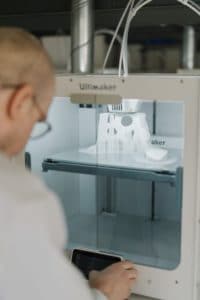Manufacturing is essentially the processing of raw materials to make a product for customers to buy. Additive manufacturing vs subtractive manufacturing is two methods of processing these raw materials to make parts or objects. Additive manufacturing is the process of adding material to create a product, while subtractive manufacturing is the process of removing material (through shaving or drilling, for example) to create a product.
In the last few decades, huge leaps in technology have drastically improved both additive manufacturing and subtractive manufacturing. Although they can be simple methods, they often refer to complicated technologies. Before comparing subtractive versus additive manufacturing, it’s important to first understand these technologies and the preferred uses of each.
What is Additive Manufacturing?

Additive manufacturing is what it sounds like: adding materials and parts to make a product. Although it sounds simple, the process is anything but. When thinking of additive manufacturing processes, the most apparent one is 3D printing. When an object is 3D printed, a 3D printer deposits material layer by layer, with each layer fusing to the last. Selective laser sintering (SLS) is one form of 3D printing that uses a high-power laser to sinter, or compact, small particles into a solid structure. This structure is based on a computer-aided design (CAD) model. If you’ve never seen a 3D printer in action, watch how they 3D print automotive parts!
Additive manufacturing is a form of green manufacturing: production processes aiming to reduce waste, reuse materials, reduce consumption, and overall make manufacturing practices more sustainable. By using additive manufacturing methods to reduce waste, manufacturers can reduce their carbon footprint and meet sustainability goals. You can also create a sustainability report to help keep the company on track with its already set goals.
What is Subtractive Manufacturing?
Subtractive manufacturing is the opposite of additive manufacturing. Instead of adding material, a cutting tool removes material from an initial block, bar, or rod to form a specific part or product. Subtractive manufacturing processes are most often done by a computer-controlled machine using computer numerical control (CNC). These machines cut, drill, bore, and grind away excess material. As with additive manufacturing, controlled machining tools create a product based on CAD models. CNC machining can be quite mesmerizing to watch.
Additive Manufacturing vs. Subtractive Manufacturing
A simple example to demonstrate the difference between these two manufacturing processes is thinking about creating a sculpture out of clay. You can either add it, layer by layer, to make a sculpture, or you can carve it from a block, subtracting the excess. Adding layers of clay and attaching parts to the sculpture is what additive manufacturing is like, whereas carving is like subtractive manufacturing.
Although the processes that these two methods of manufacturing refer to are relatively straightforward, it’s important to acknowledge that additive and subtractive technologies have come a long way. Advancements in both 3D printing and CNC machining have led to increasing access to both processes. Using these technologies (and even technology that has been used throughout this industry in the last decade), both methods of manufacturing can be incredibly precise, time-efficient, and create a reliable product.
They are also not mutually exclusive and are often used together in product development, just at different stages. One method may be preferred over the other based on what the product will be used for, its size, its complexity, and its material. For instance, additive manufacturing is great for cheap plastic prototyping, but subtractive manufacturing might be a better option for a large metal part given the fractional durability of plastic parts and prohibitive costs of metal 3D printing.
Some advantages of additive manufacturing over subtractive manufacturing include:
- Cheaper and faster plastic prototyping
- Low cost per part
- Complex and intricate small parts and designs
- Custom or replacement parts
- No waste scraps
While subtractive manufacturing can be better for:
- Larger and less complex parts
- Parts under duress such as mechanical strain
- Large batches
- More durable finished parts (as opposed to prototypes) given the speed, many options for surface finishes, and economic advantage over the metal 3D printing
Which is More Sustainable?
When comparing subtractive vs. additive manufacturing with sustainability in mind, subtractive manufacturing is almost always more wasteful, as the process of drilling and cutting produces small scraps that are often thrown out. However, efforts can be taken to mitigate this waste, such as collecting metal scraps or plastic parts and melting them down to be used for other parts using wood scraps for fuel or creating packed sawdust pellets. Other kinds of waste such as textile waste or building materials can be recycled through companies such as Just Make It Go Away, a leading recycler of materials and waste.
The durability of subtractively manufactured metal parts also needs to be taken into account. Most 3D printed parts are plastic, which can break more easily than metal and are thus by definition less sustainable. While metal 3D printing exists, it is currently costly and hard to do on a large scale. However, with how rapidly this technology is changing, hopefully, metal 3D printing can be a sustainable solution in the near future. These two manufacturing methods complement each other, and there are advantages and drawbacks to both in different situations. How does your company use subtractive vs. additive manufacturing?

